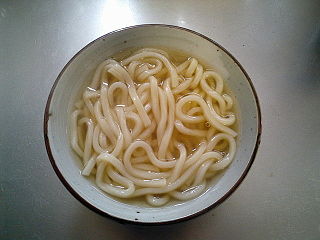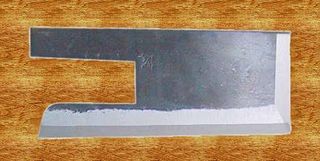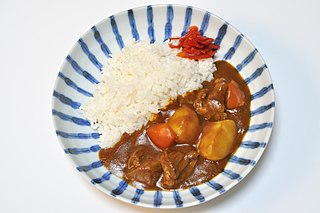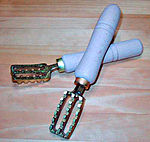
Japanese cuisine encompasses the regional and traditional foods of Japan, which have developed through centuries of political, economic, and social changes. The traditional cuisine of Japan is based on rice with miso soup and other dishes; there is an emphasis on seasonal ingredients. Side dishes often consist of fish, pickled vegetables, and vegetables cooked in broth. Seafood is common, often grilled, but also served raw as sashimi or in sushi. Seafood and vegetables are also deep-fried in a light batter, as tempura. Apart from rice, a staple includes noodles, such as soba and udon. Japan also has many simmered dishes, such as fish products in broth called oden, or beef in sukiyaki and nikujaga.

Tempura is a typical Japanese dish that usually consists of seafood and vegetables that have been coated in a thin batter and deep fried. Tempura has its origins dating back the 16th century, when Portuguese Jesuits brought the Western-style cooking method of coating foods with flour and frying, via Nanban trade.

Udon is a thick noodle made from wheat flour, used in Japanese cuisine. There is a variety of ways it is prepared and served. Its simplest form is in a soup as kake udon with a mild broth called kakejiru made from dashi, soy sauce, and mirin. It is usually topped with thinly chopped scallions. Other common toppings include prawn tempura, kakiage, abura-age, kamaboko, and shichimi spice added to taste.

Katsuobushi is simmered, smoked and fermented skipjack tuna. It is also known as bonito flakes or broadly as okaka (おかか).

Deba bōchō are Japanese style kitchen knives primarily used to cut fish, though also used when cutting meat. They come in different sizes, sometimes up to 30 cm (12 inches) in length. The deba bōchō first appeared during the Edo period in Sakai. It is designed to behead and fillet fish. Its thickness, and often a more obtuse angle on the back of the heel allow it to cut off the heads of fish without damage. The rest of the blade is then used to ride against the fish bones, separating the fillet.

A Japanese kitchen knife is a type of kitchen knife used for food preparation. These knives come in many different varieties and are often made using traditional Japanese blacksmithing techniques. They can be made from stainless steel, or hagane, which is the same kind of steel used to make Japanese swords. Most knives are referred to as hōchō or the variation -bōchō in compound words but can have other names including -kiri. There are four general categories used to distinguish the Japanese knife designs: handle, blade grind, steel, and construction.

Nakiri bōchō and usuba bōchō are Japanese-style vegetable knives. They differ from the deba bōchō in their shape, as they have a straight blade edge suitable for cutting all the way to the cutting board without the need for a horizontal pull or push. These knives are also much thinner. While the deba bōchō is a heavy blade for easy cutting through thin bones, the blade is not suitable for chopping vegetables, as the thicker blade can break the vegetable slice. The nakiri bōchō and the usuba bōchō have a much thinner blade. This does not help with cutting small bones in fish or meat, but is useful for cutting vegetables.

Yanagi-ba-bōchō, yanagi ba, or yanagi, is a long and thin knife used in the Japanese cuisine. It is the typical example of the sashimi bōchō used to slice fish for sashimi and nigiri sushi.

A maguro bōchō, or maguro kiri bōchō, is an extremely long, highly specialized Japanese knife that is commonly used to fillet tuna, as well as many other types of large ocean fish.
An unagisaki hōchō is a knife specialized for filleting eel. The sharp tip of the knife is pushed into the eel near the head, and then slid along the body of the eel to open up the entire length of the fish. Besides the standard version as shown in the picture, there are many other local styles that differ significantly for different cities in Japan like Nagoya, Osaka, and Kyoto.
Sashimi bōchō, literally "sashimi knife" is a type of long, thin knife used in Japanese cuisine to prepare sashimi. Types of sashimi bōchō include tako hiki, yanagi ba, and fugu hiki.

The udon kiri, soba kiri, and kashi kiri are a group of specialized knives used in the Japanese kitchen to make udon and soba noodles respectively. The udon kiri is also sometimes called menkiri bocho, and is distinguished from the Soba and Kashi kiri knives by a blade that drops in to cover less than half of the length of the handle rather that reaching the end of the handle like the soba. The soba kiri is characterized by a long blade that spans down the full length of the handle whereas the blade of the Kashi kiri only curves to meet the top of the handle. To make soba or udon the dough is flattened and folded, and then cut with the menkiri bocho to produce long rectangular noodles. For this purpose the menkiri bocho has a straight and long cutting edge to cut the noodles straight to the board. The knife is usually heavy to aid in the cutting of the noodles, usually with a slight forward motion.

A kitchen knife is any knife that is intended to be used in food preparation. While much of this work can be accomplished with a few general-purpose knives – notably a large chef's knife, a tough cleaver, a small paring knife and some sort of serrated blade – there are also many specialized knives that are designed for specific tasks. Kitchen knives can be made from several different materials.

A garnish is an item or substance used as a decoration or embellishment accompanying a prepared food dish or drink. In many cases, it may give added or contrasting flavor. Some garnishes are selected mainly to augment the visual impact of the plate, while others are selected specifically for the flavor they may impart. This is in contrast to a condiment, a prepared sauce added to another food item primarily for its flavor. A food item which is served with garnish may be described as being garni, the French term for "garnished."

Japanese curry is commonly served in three main forms: curry over rice, curry udon, and curry bread. It is one of the most popular dishes in Japan. The very common "curry rice" is most often referred to simply as "curry".

Japanese cuisine has a vast array of regional specialities known as kyōdo ryōri (郷土料理) in Japanese, many of them originating from dishes prepared using local ingredients and traditional recipes.















